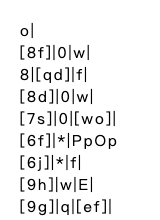Roblox Sheet

Roblox Sheet
Nocturne in E-flat Major, Op. 9, No. 2
Frédéric Chopin
Ощутите Nocturne in E-flat Major, Op. 9, No. 2 от Frédéric Chopin совершенно новым способом! Используйте вашу клавиатуру, чтобы играть Nocturne in E-flat Major, Op. 9, No. 2 Roblox Пианино Листы на Виртуальной Клавиатуре. Независимо от того, являетесь ли вы игроком Roblox пианино игры или хотите практиковать классические произведения, этот Nocturne in E-flat Major, Op. 9, No. 2 Roblox Пианино Лист идеально подходит для вас, помогая легко переходить от новичка к эксперту. Nocturne in E-flat Major, Op. 9, No. 2 находится в ТОП 100 Roblox Пианино Листов, наряду с множеством других простых, классических, поп, рождественских и диснеевских песен для игры!
527 просмотров
Roblox Sheet

Roblox Sheet
Nocturne in E-flat Major, Op. 9, No. 2 (easier version)
Frédéric Chopin
Ощутите Nocturne in E-flat Major, Op. 9, No. 2 (easier version) от Frédéric Chopin совершенно новым способом! Используйте вашу клавиатуру, чтобы играть Nocturne in E-flat Major, Op. 9, No. 2 (easier version) Roblox Пианино Листы на Виртуальной Клавиатуре. Независимо от того, являетесь ли вы игроком Roblox пианино игры или хотите практиковать классические произведения, этот Nocturne in E-flat Major, Op. 9, No. 2 (easier version) Roblox Пианино Лист идеально подходит для вас, помогая легко переходить от новичка к эксперту. Nocturne in E-flat Major, Op. 9, No. 2 (easier version) находится в ТОП 100 Roblox Пианино Листов, наряду с множеством других простых, классических, поп, рождественских и диснеевских песен для игры!
53 просмотров
Roblox Sheet

Roblox Sheet
Nocturne in E-flat Major, Op. 9, No. 2
Frédéric Chopin
Ощутите Nocturne in E-flat Major, Op. 9, No. 2 от Frédéric Chopin совершенно новым способом! Используйте вашу клавиатуру, чтобы играть Nocturne in E-flat Major, Op. 9, No. 2 Roblox Пианино Листы на Виртуальной Клавиатуре. Независимо от того, являетесь ли вы игроком Roblox пианино игры или хотите практиковать классические произведения, этот Nocturne in E-flat Major, Op. 9, No. 2 Roblox Пианино Лист идеально подходит для вас, помогая легко переходить от новичка к эксперту. Nocturne in E-flat Major, Op. 9, No. 2 находится в ТОП 100 Roblox Пианино Листов, наряду с множеством других простых, классических, поп, рождественских и диснеевских песен для игры!
35 просмотров
Roblox Sheet

Roblox Sheet
Nocturne in E-flat Major, Op. 9, No. 2
Frédéric Chopin
Ощутите Nocturne in E-flat Major, Op. 9, No. 2 от Frédéric Chopin совершенно новым способом! Используйте вашу клавиатуру, чтобы играть Nocturne in E-flat Major, Op. 9, No. 2 Roblox Пианино Листы на Виртуальной Клавиатуре. Независимо от того, являетесь ли вы игроком Roblox пианино игры или хотите практиковать классические произведения, этот Nocturne in E-flat Major, Op. 9, No. 2 Roblox Пианино Лист идеально подходит для вас, помогая легко переходить от новичка к эксперту. Nocturne in E-flat Major, Op. 9, No. 2 находится в ТОП 100 Roblox Пианино Листов, наряду с множеством других простых, классических, поп, рождественских и диснеевских песен для игры!
33 просмотров
Roblox Sheet

Roblox Sheet
Nocturne in E-Flat Major, Op. 9, No. 2
Frédéric Chopin
Ощутите Nocturne in E-Flat Major, Op. 9, No. 2 от Frédéric Chopin совершенно новым способом! Используйте вашу клавиатуру, чтобы играть Nocturne in E-Flat Major, Op. 9, No. 2 Roblox Пианино Листы на Виртуальной Клавиатуре. Независимо от того, являетесь ли вы игроком Roblox пианино игры или хотите практиковать классические произведения, этот Nocturne in E-Flat Major, Op. 9, No. 2 Roblox Пианино Лист идеально подходит для вас, помогая легко переходить от новичка к эксперту. Nocturne in E-Flat Major, Op. 9, No. 2 находится в ТОП 100 Roblox Пианино Листов, наряду с множеством других простых, классических, поп, рождественских и диснеевских песен для игры!
32 просмотров
Roblox Sheet

Roblox Sheet
Nocturne in E-flat major, Op. 9, No. 2
Frédéric Chopin
Ощутите Nocturne in E-flat major, Op. 9, No. 2 от Frédéric Chopin совершенно новым способом! Используйте вашу клавиатуру, чтобы играть Nocturne in E-flat major, Op. 9, No. 2 Roblox Пианино Листы на Виртуальной Клавиатуре. Независимо от того, являетесь ли вы игроком Roblox пианино игры или хотите практиковать классические произведения, этот Nocturne in E-flat major, Op. 9, No. 2 Roblox Пианино Лист идеально подходит для вас, помогая легко переходить от новичка к эксперту. Nocturne in E-flat major, Op. 9, No. 2 находится в ТОП 100 Roblox Пианино Листов, наряду с множеством других простых, классических, поп, рождественских и диснеевских песен для игры!
29 просмотров
Roblox Sheet

Roblox Sheet
Nocturne in E-flat Major, Op. 9, No. 2
Judrod Lanstan
Ощутите Nocturne in E-flat Major, Op. 9, No. 2 от Judrod Lanstan совершенно новым способом! Используйте вашу клавиатуру, чтобы играть Nocturne in E-flat Major, Op. 9, No. 2 Roblox Пианино Листы на Виртуальной Клавиатуре. Независимо от того, являетесь ли вы игроком Roblox пианино игры или хотите практиковать классические произведения, этот Nocturne in E-flat Major, Op. 9, No. 2 Roblox Пианино Лист идеально подходит для вас, помогая легко переходить от новичка к эксперту. Nocturne in E-flat Major, Op. 9, No. 2 находится в ТОП 100 Roblox Пианино Листов, наряду с множеством других простых, классических, поп, рождественских и диснеевских песен для игры!
22 просмотров



















